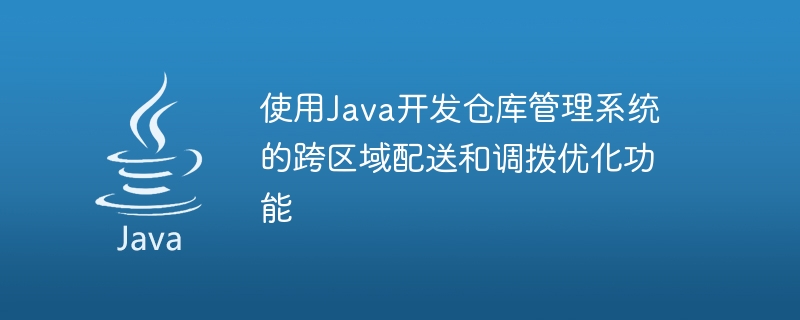Home >Java >javaTutorial >Using Java to develop the cross-regional distribution and allocation optimization functions of the warehouse management system
Using Java to develop the cross-regional distribution and allocation optimization functions of the warehouse management system
- 王林Original
- 2023-09-24 09:05:071331browse

Use Java to develop the cross-regional distribution and allocation optimization functions of the warehouse management system
In the modern economy, logistics distribution is a very important part of supply chain management. With the rapid development of e-commerce, the efficiency and accuracy of logistics distribution have become the key to enterprise competition. The development of a warehouse management system's cross-regional distribution and allocation optimization functions will significantly enhance the company's logistics and distribution management capabilities.
In this article, we will use Java to develop a warehouse management system that has cross-regional distribution and allocation optimization functions. We will discuss the functional requirements of the system in detail and provide some concrete code examples.
The first step is to design the basic functions of the system. We need a warehouse management system that can automate cross-regional distribution and optimize allocations. Specific functions include logistics route planning, order allocation, delivery personnel management, delivery vehicle management, etc. In order to better manage the complexity of the system, we can use object-oriented design patterns, such as factory pattern, singleton pattern, strategy pattern, etc. The following is a simple sample code that shows how to use the strategy pattern to implement the logistics route planning function:
public interface RoutePlanningStrategy {
List<Location> planRoute(List<Location> locations);
}
public class FastestRoutePlanningStrategy implements RoutePlanningStrategy {
@Override
public List<Location> planRoute(List<Location> locations) {
// 实现最快路线规划算法
return fastestRoutePlan;
}
}
public class ShortestRoutePlanningStrategy implements RoutePlanningStrategy {
@Override
public List<Location> planRoute(List<Location> locations) {
// 实现最短路线规划算法
return shortestRoutePlan;
}
}
public class Warehouse {
private RoutePlanningStrategy routePlanningStrategy;
public void setRoutePlanningStrategy(RoutePlanningStrategy routePlanningStrategy) {
this.routePlanningStrategy = routePlanningStrategy;
}
public List<Location> planRoute(List<Location> locations) {
return routePlanningStrategy.planRoute(locations);
}
}
public class Main {
public static void main(String[] args) {
Warehouse warehouse = new Warehouse();
warehouse.setRoutePlanningStrategy(new FastestRoutePlanningStrategy());
List<Location> locations = new ArrayList<>();
// 添加需要规划的地点
List<Location> routePlan = warehouse.planRoute(locations);
System.out.println("最快路线规划结果:" + routePlan);
warehouse.setRoutePlanningStrategy(new ShortestRoutePlanningStrategy());
routePlan = warehouse.planRoute(locations);
System.out.println("最短路线规划结果:" + routePlan);
}
}In the above code, we define a RoutePlanningStrategy interface for the definition of strategy. Then, we implemented two specific strategy classes FastestRoutePlanningStrategy and ShortestRoutePlanningStrategy, which represent the fastest route planning and the shortest route planning respectively. Finally, we used the strategy pattern in the Warehouse class to choose different route planning strategies according to different needs.
In addition to the route planning function, the warehouse management system also needs to implement functions such as order allocation, delivery personnel management, and delivery vehicle management. In terms of order allocation, we can use a greedy algorithm to deal with it. For specific implementation, please refer to the following code example:
public class Order {
private Location location;
private int quantity;
public Order(Location location, int quantity) {
this.location = location;
this.quantity = quantity;
}
// get/set methods...
@Override
public String toString() {
return "Order{" +
"location=" + location +
", quantity=" + quantity +
'}';
}
}
public class OrderAllocator {
public List<Order> allocateOrders(List<Order> orders, List<Location> deliveryLocations) {
List<Order> allocatedOrders = new ArrayList<>();
// 按照一定的规则进行订单分配,比如可用库存量、距离等
// ...
return allocatedOrders;
}
}
public class Main {
public static void main(String[] args) {
List<Order> orders = new ArrayList<>();
// 添加订单
List<Order> allocatedOrders = new OrderAllocator().allocateOrders(orders, deliveryLocations);
System.out.println("订单分配结果:" + allocatedOrders);
}
}In the above code, we define an Order class to represent the order, including the location and quantity of the order. We then use the OrderAllocator class to handle the order allocation logic. In the allocateOrders method, we can allocate orders according to certain rules, such as available inventory or distance and other indicators. Finally, we can see the results of the order allocation in the Main class.
As for the implementation of delivery personnel management and delivery vehicle management functions, a database can be used to store and manage relevant information. We can define the relevant data model and database table structure, and then use Java database operation tools, such as JDBC or ORM framework to operate the database. The specific code examples to implement this part of the function are beyond the scope of this article, and readers can implement them according to their own needs and actual conditions.
Through the above introduction, we can see that it is feasible to use Java to develop the cross-regional distribution and allocation optimization functions of the warehouse management system. This article provides some code examples to show how specific features are implemented. At the same time, readers can further improve and optimize these codes according to their own needs. I hope this article is helpful to readers, and I wish you smooth development of your warehouse management system!
The above is the detailed content of Using Java to develop the cross-regional distribution and allocation optimization functions of the warehouse management system. For more information, please follow other related articles on the PHP Chinese website!
Related articles
See more- Easy to understand! Detailed explanation of VUEX state warehouse management
- How to use PHP and Vue to develop returns management functions for warehouse management
- How to use PHP and Vue to develop inventory counting functions for warehouse management
- How to use PHP and Vue to implement the loss reporting function of warehouse management
- How to use PHP and Vue to develop cargo tracking functions for warehouse management

